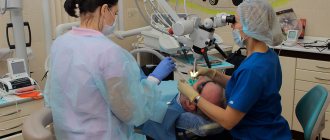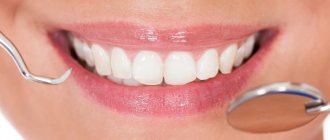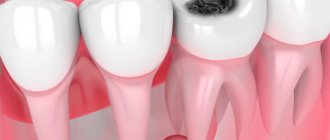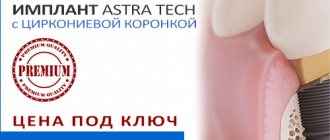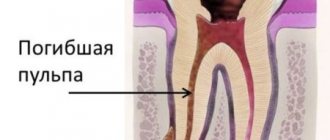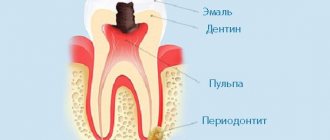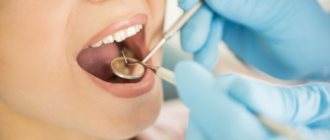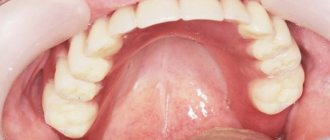Questions and answers on: tooth hurts under a filling
The most common questions patients ask after tooth filling concern pain.
- Question : “A month ago, I had a tooth healed using paste to kill the nerve and installing a temporary filling, but it hurts when pressed. Also, the gums on the cheek side were swollen. After the temporary filling fell out, I did not install a new one. What to do? Is it related to the root or the nerves?” Answer : “Most likely, the periosteum became inflamed because the canals were not treated in time. It was necessary to treat them and put a permanent filling. In your case, the tooth needs to be removed, but if you consult a doctor urgently, there is a small chance of saving it.”
- Question : “Can a tooth hurt after filling? It’s been 2 hours since the filling was placed, but I feel a little pain.” Answer : “Mild pain in a filled tooth is a natural physiological reaction to surgical intervention in the dental cavity. Periodic painful sensations may be felt for 2 months until complete healing. They will pass unless the pain becomes more severe and increasing.”
- Question : “Yesterday we got a filling, but the tooth still hurts. A small rash and itching appeared near him. I can’t stand it any longer, what should I do?” Answer : “You need to see a doctor to replace the filling. You have developed an allergic reaction to it. This is quite a rare occurrence."
- Question : “A week ago I was treated for caries and a filling was placed at the 6th unit below. But the tooth did not stop hurting. It especially bothers me at night; I can’t sleep due to the throbbing pain. Should a tooth hurt after filling?” Answer : “Most likely, the dentist treated you for deep caries due to periodontitis or chronic pulpitis and made a mistake, guided only by a visual examination of the oral cavity. In any case, it was necessary to take an x-ray of the tooth affected by caries. We urgently need to remove the filling and treat the canals.”
- Question : “2 weeks ago a permanent filling was placed without removing the nerve, but it still hurts me to chew. In addition, the tooth reacts to cold and hot food and at times there is aching pain.” Answer : “Such symptoms may indicate the development of chronic pulpitis or the development of an abscess inside the tooth.”
If various pains appear in the tooth after the filling procedure, then the only recommendation is to contact a qualified specialist. After all, the reasons can be completely different.
What not to do?
If, after treatment, a tooth hurts when pressed or without mechanical action, you should under no circumstances resort to folk remedies such as heating, hot compresses, heating pads - if there is an inflammatory process, this can greatly worsen the condition. In case of allergic reactions, heat will also increase swelling.
It is also not recommended to use folk remedies for rinsing, which can cause a burn to the mucous membrane - iodine, tinctures of alcohol or vodka, liquids with the juice of “scorching” plants, etc. Even if there is no gum damage, such measures can worsen the situation.
It is also not worth taking various painkillers uncontrollably - firstly, you need to see a doctor in any case, and the effect of analgesics will not allow you to fully evaluate the clinical picture. Secondly, it can be dangerous to health.
It is important to visit a doctor at the first opportunity and perform all the necessary procedures to eliminate unpleasant consequences and improve the condition.
Tooth hurts after nerve removal and filling
Only a dentist after an examination will help you figure out why a tooth hurts after removing a nerve and filling its canals. Treating teeth on your own without a diagnosis is highly discouraged.
In dental practice, the procedure for treating tooth canals by removing a nerve is a rather complex manipulation. Cases of medical error are common. They are fraught with various complications, in which the filled tooth continues to hurt.
The main reason why a “dead tooth” (without a nerve) is bothersome is:
- removal of the filling material beyond the apex of the tooth - this occurs due to incorrect definition
- working tooth length;
- the doctor filled the canal incorrectly;
- a tool broke off in the canal;
- root perforation of the tooth;
- If your tooth aches, you may be allergic to the filling material.
It is worth considering that a tooth under a filling can hurt even without a nerve. After all, during the extraction procedure, only a small part of it is removed from the root canal, which branches off from the main nerve trunk. In addition, when removing and filling canals, dental tissues are damaged. When an anesthetic is applied to a tooth, pain is not felt; it begins to be felt after the anesthesia wears off. Such painful sensations are called post-filling.
After removal of a nerve, neighboring teeth can often be bothered, but it seems as if it is the treated tooth that is hurting. An experienced doctor will examine the dentition to identify and eliminate this problem. However, it is worth sounding the alarm when the nerve has been removed for a long time, and the tooth continues to hurt - this symptom may signal the development of chronic pulpitis or periodontitis.
One of the root canals was not processed
This is one of the rarest complications, since before starting endodontic treatment the doctor will definitely prescribe an x-ray diagnosis. It allows you to reliably determine the number of channels and evaluate their structure. But there are cases of abnormal location of root canals or their extremely small sizes, which makes them unnoticed in the image.
This leads to the following situation: the doctor removes the pulp in each canal, but one remains unattended - the inflamed pulp continues to hurt, and pathogenic bacteria continue to multiply. Such pain is difficult to confuse with other complications - the patient simply does not receive relief after treatment, and the pain characteristic of pulpitis itself remains. The sensations are pulsating in nature, the pain intensifies when eating, exposure to temperature on the tooth, and becomes unbearable at night.
The same symptoms can be observed with incomplete removal of the pulp in the diagnosed canal. In both cases, other symptoms may be observed:
- headache, sensations “radiate” to the ear, temple - depending on the specific tooth;
- increased body temperature;
- symptoms of general malaise.
Most complications are related to the complexity of the canal structure, and the following is no exception.
Tooth hurts after root canal filling
Dental clinic patients are often concerned about the question of why their tooth hurts after inserting filling material into the tooth canal after removal of the nerve. Since any intervention in the body has its consequences, toothache is an “echo” of the filling procedure.
The most common reasons for a tooth to ache after root canal filling are:
- burns and overdrying of dentin;
- allergic reaction to filling material;
- depressurization of the seal;
- change in bite;
- exposure to polymerization lamps;
- shrinkage of the filling.
After the procedure, the dentist usually advises you on how long the tooth under the filling hurts. However, if you feel increasing pain in a filled tooth for more than 2 weeks, you should urgently consult a doctor. Such pain can occur when an instrument breaks off in the canal, root perforation, or improper treatment of pulpitis.
Instrument breakage in the root canal
After treatment of pulpitis, the tooth may also hurt due to a broken instrument. Part of it remains in the root canal, and unpleasant sensations occur immediately or a few days after the visit to the dental office.
The nature of the pain may vary depending on the size of the fragment and other conditions.
It is worth noting that this complication is quite rare. This is explained by the fact that a good dental clinic uses modern, high-quality instruments from reliable manufacturers that are sufficiently durable. In addition, the rules for their use must be strictly observed, including multiplicity, force during exposure, etc. And finally, the doctor will notice the presence of a foreign body in the tooth on a control image, which he will prescribe after treatment.
Does calcium help maintain teeth in old age?
Yes, in old age, taking calcium supplements helps preserve your teeth. A study was conducted that confirmed this fact. So, two groups of people after 65 years of age took three years in a row: the first took calcium supplements and vitamin D, the second took a placebo (“dummies”). After this, the subjects were observed for another two years. It turned out that in the first group people lost teeth less often than in the second. But this is not due to the fact that calcium makes teeth stronger. Here, the main role was played by strengthening the jaws, and consequently, better fixation of the tooth in the jaw.
Equipment for depophoresis
The active substance is delivered to the affected area using special equipment. At the moment, highly specialized devices for depophoresis are produced solely by the company HUMANCHEMIE, which produces only one model - ORIGINAL II. The device is officially approved by the developer of the method and has a full functional set for high-quality and convenient performance of the procedure in a modern dental clinic:
- sets the duration of the session;
- sets the current strength;
- controls the stage of the procedure (taking into account the current strength and time).
All other examples of devices are complex devices designed to perform several dental procedures.
In addition to technology, to perform the procedure efficiently, you will need a set of specific drugs:
- Disinfectant compositions are represented by various suspensions based on copper and calcium hydroxide - cupral. Various versions come in the form of a powder (diluted in water to form a solution for depophoresis) or a paste (used to temporarily seal canals). Taking into account the main active ingredient, the depophoresis technique is also called cupral-depophoresis.
- Atatsamite is a powder preparation of plastic bactericidal cement for final filling of sterile dental canals.
REFERENCE! In some cases, calcium hydroxide is used to disinfect canals, but a mixture of calcium and copper hydroxides increases efficiency tenfold, which makes the use of cupral relevant as the main drug for depophoresis.
Is calcium washed out of teeth during pregnancy?
This is a very common opinion: it is believed that the unborn baby “takes” calcium from the mother’s teeth, and it is from this that the bones of the fetus are formed. This is the cause of tooth decay, which often occurs during pregnancy. However, doctors do not share this opinion.
Yes, the baby growing in the mother’s belly really needs calcium in order for its tissues to form correctly. And therefore, during pregnancy, a woman should receive a sufficient amount of this element. But it has not been proven by science that the mother’s teeth suffer due to its deficiency.
In fact, if there is insufficient calcium intake during pregnancy, the baby's risk of tooth decay increases later. This has been confirmed by studies in which pregnant women regularly took calcium supplements. In the future, the children of these women had less caries than their peers whose mothers did not receive calcium.
This means that pregnant women need to take calcium to ensure that their baby has strong teeth in the future, not to keep their own teeth healthy.
But what about the fact that after the birth of a child, many mothers experience dental problems? Doctors explain this for other reasons. For example, during pregnancy a woman often vomits. At the same time, the acid content in the mouth increases, which affects the enamel, destroying it. To avoid this, you need to rinse your mouth thoroughly after vomiting, but you should not brush your teeth, mechanically irritating the enamel.
Another reason for tooth damage during pregnancy may be insufficient hygiene associated with gum inflammation - gingivitis, which develops in a woman under the influence of hormonal changes.
Poor nutrition, in particular a passion for carbohydrate foods, untreated caries before pregnancy, and tartar if a woman neglects to brush her teeth at the dentist also contribute.
How is depophoresis performed in dentistry?
The preparatory stage includes radiography of the tooth. The number of roots, the length and shape of the dental canals, the presence and location of infection are assessed. The more detailed the diagnosis, the higher the effectiveness of treatment.
The depophoresis procedure is performed only on “dead” teeth, so preliminary devitalization (pulp removal) will be required.
The depophoresis procedure itself consists of 2-3 sessions, which are carried out with a break of a week. Sequencing:
- Local anesthesia is performed using application and infiltration anesthesia.
- The tooth is opened to gain access to the canals and the cavity is expanded to the required size.
- The channels are filled with calcium-copper hydroxide.
- Electrodes are installed (a negative charge is inserted into the dental canal to a depth of 8 mm, a positive charge is placed on the inside of the cheek near the problem tooth).
- Electric current is applied, gradually increasing the power until the patient feels warmth in the affected area. On average, the current level reaches 2 mA - this is enough to start the process of electrophoresis of copper and calcium ions into the adjacent tooth tissue.
- The procedure is completed by washing with distilled water (or a 10% hydroxide solution) and temporarily sealing the canal with a paste, again, with calcium hydroxide.
The whole job takes just over 5 minutes. 1 channel is processed per session.
ATTENTION! Simultaneous depophoresis of several channels is undesirable. This will lead to uneven distribution of current and a decrease in the quality of the procedure.
The last session is the final one. It involves re-processing with disinfection of the smallest tubules and sealing the tooth with a plastic cement composition with an antibacterial effect. Finally, the dentist installs a filling, which can be permanent or temporary (with subsequent replacement with an inlay).
For complete safety, a control x-ray of the tooth is taken.
ATTENTION! In case of increased tooth sensitivity (acute pain during a depophoresis session), the breaks between sessions can be increased to 2-3 weeks.

